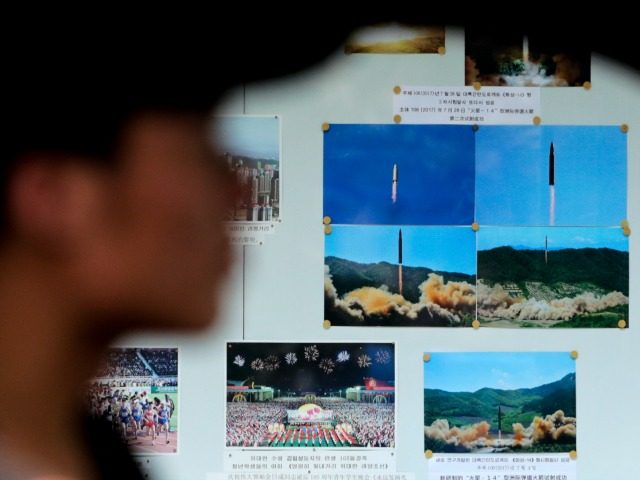The communist regime of North Korea launched two short-range projectiles Tuesday after its Foreign Ministry published a scathing statement warning South Korea and the United States that Pyongyang will continue to “develop, test, and deploy” weapons against them.
The projectiles, believed to be missiles that crashed into the Sea of Japan, represent the fourth such launch in two weeks. The Foreign Ministry’s statement is a response to Washington and Seoul launching joint military drills this weekend, the first ever led by a South Korean, not an American, general.
North and South Korea – and, by proxy, China and America – have been in a state of war since 1950. The active period of the Korean War ended with an armistice agreement in 1953, but no party ever signed a peace treaty, which has allowed a continued American presence in Korea and maintained the tense status of the Demilitarized Zone (DMZ), the official name of the border between the two Koreas.
Last week, following the third missile launch in the past month, President Donald Trump said he was not concerned given that the missiles did not appear to violate U.S. sanctions, though they may run afoul of United Nations rules.
The U.S. and South Korea have postponed and canceled some military exercises during times of dialogue with the North, but have refused to shut down the current drills, which both sides deem necessary to maintain military preparedness given the state of war.
An unnamed North Korean Foreign Ministry spokesperson rejected the legitimacy of any such exercises on Tuesday.
“Despite our repeated warnings, the United States and south Korean authorities have finally started the joint military exercise targeting the DPRK [Democratic People’s Republic of Korea],” the spokesperson said. “This is an undisguised denial and a flagrant violation of June 12 DPRK-U.S. Joint Statement, Panmunjom Declaration and September Pyongyang Joint Declaration, all of which are agreements to establish new DPRK-U.S. relations and build a lasting and stable peace regime on the Korean peninsula.”
The mentioned statements were the result of in-person meetings between dictator Kim Jong-un and South Korean President Moon Jae-in. The June 12 statement, or Singapore Declaration, is an agreement signed by Trump and Kim during their in-person meeting in June 2018, which committed them both to work vaguely towards “denuclearization of the Korean peninsula.”
North Korea regularly uses the term “denuclearization of the Korean peninsula” to mean the removal of U.S. troops, as America is a nuclear power.
North Korean media also do not capitalize the name of South Korea, considering it the southernmost, rogue province of a united communist DPRK.
The North Korean spokesperson concluded the military exercises prove neither rival country has the “political will” to improve relationships with the communist rogue state and declared that, as both America and South Korea have not listened to calls to cancel their necessary military exercises, “we are compelled to develop, test, and deploy the powerful physical means essential for national defense.”
“The U.S. and south Korean authorities remain outwardly talkative about dialogue. But when they sit back, they sharpen a sword to do us harm,” the spokesman concluded. “If this is what they call ‘creative approach’ and ‘imaginative power beyond common sense’ [sic], we will be compelled to seek a new road as we have already indicated.”
The statement did not elaborate on what the “new road” will be, aside from the promise to develop new weapons.
In addition to the government statement, state newspaper Rodong Sinmun published an article Tuesday praising dictator Kim as a “peerlessly great man who leads the revolution with lofty love for people.”
“He is the paramount incarnation of the love for the people ever known in history,” the newspaper gushed. “His love for the people sprouted and grew stronger and turned into an unshakable view of life and revolutionary philosophy when he was sharing joys and sorrows with the great leader and the great people and making a revolution with them.”
To support its foreign ministry, North Korea launched two projectiles into the Sea of Japan, known in Korea as the East Sea, on Tuesday, both of which South Korean authorities believe flew about 280 miles before crashing into the sea.
“South Korean and U.S. intelligence authorities believe that these short-range missiles bear similar flight features to the ballistic missiles North Korea test-fired on July 25,” South Korea’s Joint Chiefs of Staff said on Tuesday, according to the Korean news service Yonhap. “Our military is monitoring the situation in case of additional launches and maintaining a readiness posture.”
South Korean Defense Ministry spokesperson Choi Hyun-soo told reporters the projectiles were “a violation of the spirit of the inter-Korean military agreement,” refusing to directly call them a violation of international sanctions, given the little information about their nature currently public.
North Korea launched missiles on July 25, July 31, and August 2 before Tuesday’s, all short-range and sinking into the Sea of Japan.
Despite North Korea’s complaints, South Korean and American military officials confirmed that the exercises, led by Combined Forces Command (CFC) Deputy Commander Gen. Choi Byung-hyuk, began this weekend. The Korea Times reported on Monday that a formal announcement, including the name of the operations and details on what the soldiers practiced, is expected later in the month as the exercises themselves conclude out of the public eye.
Following the August 2 launch, President Trump said the missiles were “not a violation of our signed Singapore agreement” but allowed, “there may be a United Nations violation.”
“Chairman Kim does not want to disappoint me with a violation of trust, there is far too much for North Korea to gain,” Trump added.

COMMENTS
Please let us know if you're having issues with commenting.